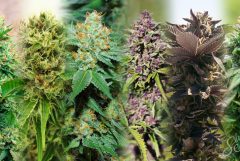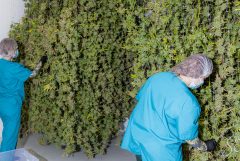Human beings have been cultivating cannabis for thousands of years and for many different reasons. We have found many different purposes for cannabis, ranging anywhere from entheogenic use to industrial production of hemp. The variety of different uses we have found for cannabis is a perfect example of the versatility of this plant. Join us in our exploration of the history of cannabis agriculture.
Cannabis is one of those plants that has been able to spread its seed all around the world without the assistance of human beings. It was growing all around the globe long before people were able to transport it for economic reasons. However, our look into the history of cannabis is going to be an exploration into all the reasons human beings have cultivated this plant, a journey from China in 2,500 BC to the modern-day world.
Chinese cultivation of cannabis
It is argued that cannabis cultivation began in Central Asia and was cultivated for the purpose of using its fibres to make products. The first record of this was in about 100 BC, when the Chinese were cultivating cannabis for the purpose of making paper. China was coined “the land of mulberry and cannabis” at the time because of the abundance of these two plants, and with these two plants together they were able to manufacture paper. Before actual cultivation, the Chinese were using cannabis plants to make Chinese medicine because of its curative and intoxicating properties.
The Chinese were clever in using tools for retting the stems, the part of the plant which was responsible for creating the fibres used to manufacture industrial materials. However, it is argued that this intelligence came from Taiwan, where pottery was discovered that contained traces of hemp fibre. With these fibres, the Chinese created fishing nets, clothing, shoes, and even sails for ships. Eventually, this led to the production of writing materials, which gave the world hemp paper.
English agriculture of cannabis
Cannabis was first cultivated by the British around 400 AD, and it was usually grown around the coastal areas. The British took a book from the page of the Chinese and began growing cannabis for the purpose of making industrial products out of it. They cultivated cannabis and extracted its fibres to make rope out of something a lot like vegetable fibre, as they found it to be stronger than plants such as stinging nettle.
In 1533, Henry VIII made a decree that compelled landlords to dedicate at least .42% of their tillable land to the cultivation of the hemp plant. He did this as a necessary measure to expand his navy and the products they were going to require to build their ships. This ensured that there was a sufficient amount of material to produce the fibres necessary. Elizabeth I even found it necessary to impose a fine to any landowner who refused to grow the hemp plant on their property. Eventually, the demand for hemp became so huge in England that they began to colonize new lands solely for the purpose of having more space to cultivate hemp. During this time, hemp was one of the biggest parts of the British economy.
The history of cannabis in Europe
Although the exact time of cannabis’ arrival in Europe is unknown, it is likely that it was quite early. The first artefact discovered that contained cannabis in Europe was found in Berlin and contained cannabis seeds and cannabis leaves, and it is believed that this artefact dates back to 500 BC. However, the agriculture of cannabis in Europe began in the early 13th century, and it was usually for the purpose of making clothes.
Hemp was used to make cloth in Southern Europe, which was effectively turned into clothes and other materials. The Italians were famous for making fine Italian linen out of the hemp plant, and this linen was only available to those who belonged higher up in the social hierarchy. The Europeans were the first people responsible for the material hempflax, which is a combination of hemp and flax. These two plants were used together in the same material, and they were used to produce fibres for clothes, rope, and other industrial products.
The Spanish were quite popular in Europe for their love of cultivating cannabis, and they were the ones who eventually brought the agriculture of this plant to South America. The Spanish were responsible for taking the cultivation of this plant to Peru and Chile, and, in fact, King Philip of Spain was quite the cannabis lover. He followed the lead of Queen Elizabeth and demanded that cannabis be grown throughout his entire empire, which began in modern-day Argentina and finished in modern-day Oregon.
Modern-day cultivation
Cultivation of this plant became stunted after it became prohibited around most of the world in the early 1900s. The cultivation of cannabis became mostly illegal and was only being cultivated for its intoxicating properties. It has been the most prevalent substance in the illegal drug trade for years, but in the last couple of decades has taken a turn for the better. In modern times, cannabis is now being cultivated for its medical properties, and the technology involved in cultivating this plant has allowed for a plethora of different strains of cannabis to become available.
Although the most common reason for cultivating cannabis in the modern world is for medicine, the move is slowly being made back to the industrial cultivation of hemp. We are slowly coming back to terms with the fact that hemp is a great plant for making paper, clothes, and houses, among other things. The UN estimates that there are over 250,000,000 users of cannabis around the world, although most of them are using it for recreational reasons.
The USA is home to some of the biggest cannabis cultivation sites, growing it for medical research and for medical use. Whereas once upon a time it was impossible to grow cannabis indoors, this is one of the most common methods of cultivating cannabis in the modern-day world. This is because the primary focus of cannabis now is to contain a high THC content, the psychoactive component. Human beings are currently using cannabis for its ability to intoxicate, and this is why it is preferred that there is a high THC content. However, there are many out there now using cannabis as medicine, and so technology is allowing for the cultivation of cannabis that contains only CBD (a medical cannabinoid that does not intoxicate).
From medicine to material to medicine
We are coming full circle with the cannabis plant, beginning our connection with it through the use of Chinese medicine, and then making a move to the industrial cultivation of cannabis or hemp. We are now returning to the medicinal and industrial properties after prohibiting its use and cultivation for quite a number of decades. We have lost touch with the powerful uses of this plant and are just now revisiting this ancient connection.










